Abstract
A program was implemented to increase the manual signing of five profoundly retarded and four autistic youth within their daily environment. Each participant was nonvocal or minimally vocal. The program was based on modified incidental teaching strategies and was implemented by direct care personnel under supervision in an institutional setting. Specific components included rearranging the physical environment to prompt signing, altering routine staff-resident interactions to prompt, manually guide and/or reinforce signing; and conducting mini-training sessions. Additionally, staff modeled signs intermittently throughout the day. The program was sequentially implemented during two staff work shifts on each of two resident living modules. Observations conducted at four separate time periods during the day indicated that significant increases in signing occurred for all participating youth and that the increases generally maintained during follow-up checks at 5 and 17 weeks. Differential effects of the increased signing on frequency of vocalizations were noted across residents. A staff acceptability survey indicated favorable staff reports on the usefulness of signing to communicate with the youth. Results are discussed regarding the significance of manual signing for seriously developmentally disabled persons and the importance of ensuring that signing skills are used in the daily environment and not exclusively in formal training sessions. Also, areas for continued research are noted in terms of more refined analyses of client skills and subsequent progress in manual communication programs.
Keywords: sign language, incidental teaching, autistic children, retarded children, developmentally disabled
Full text
PDF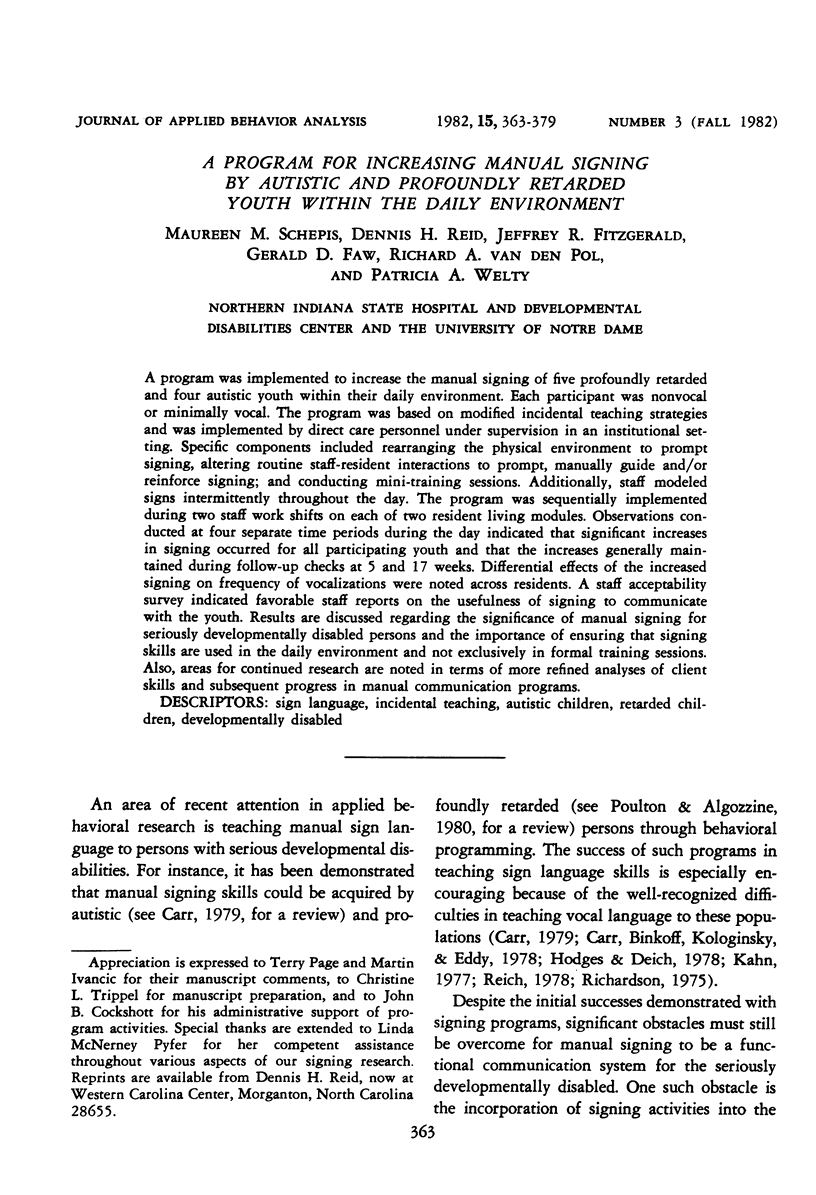
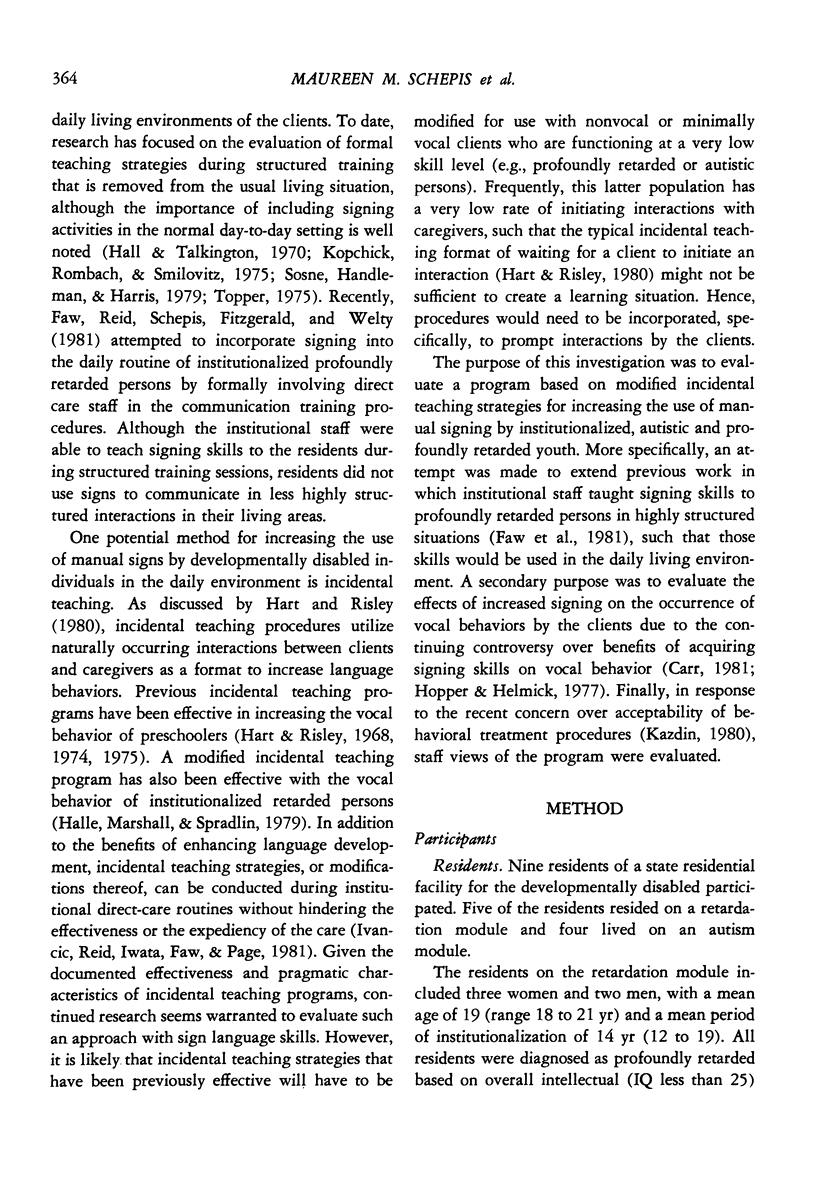
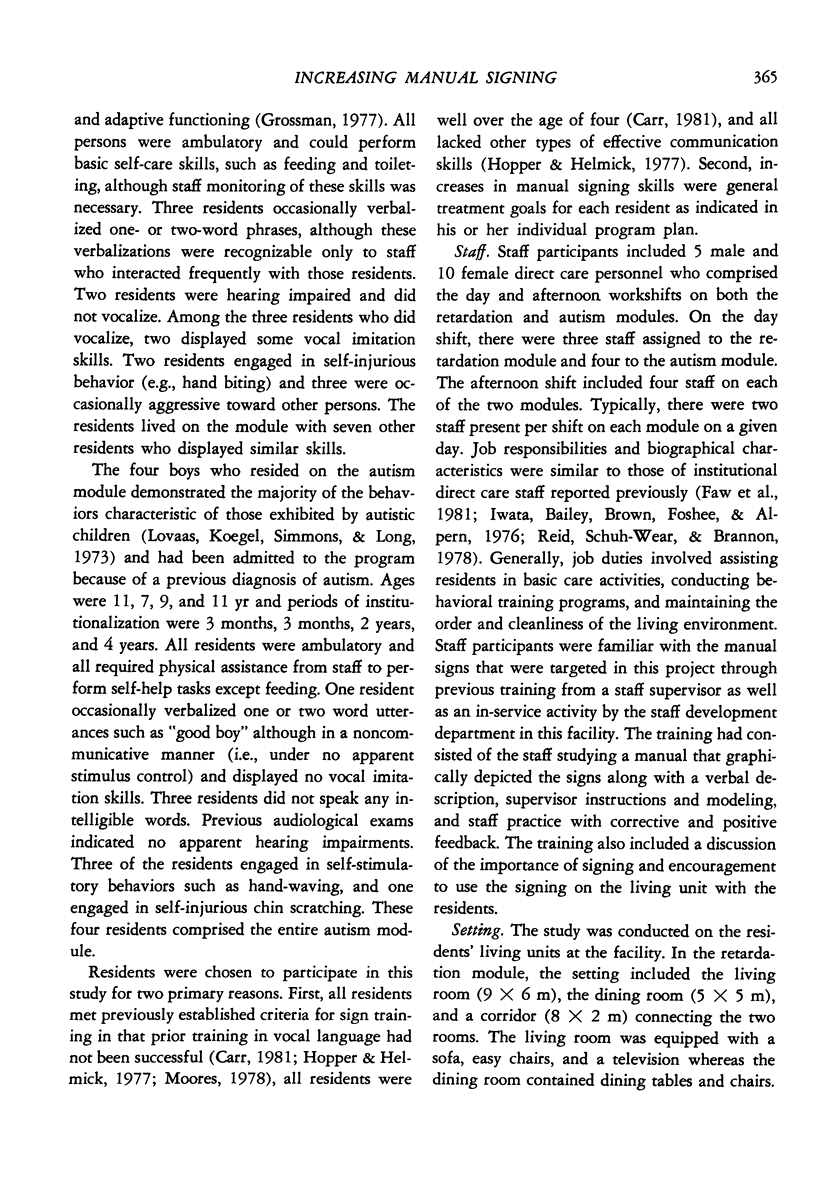
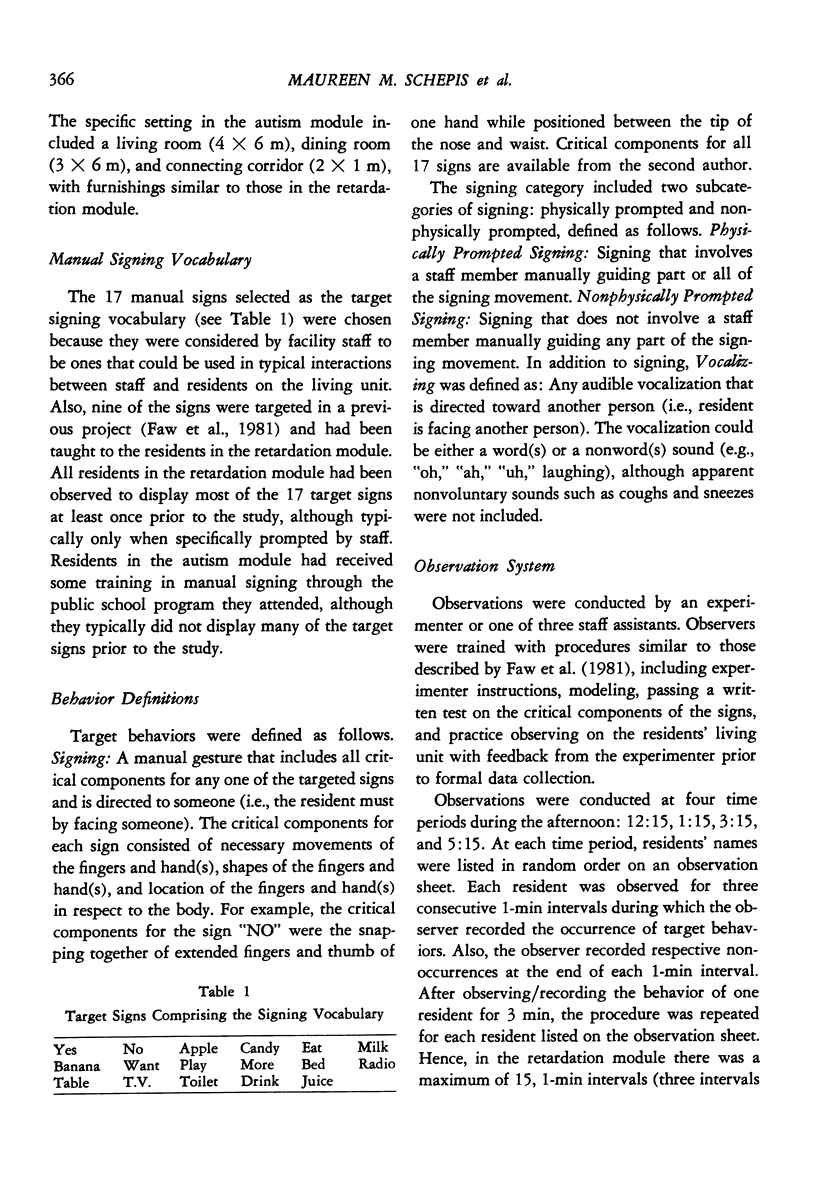

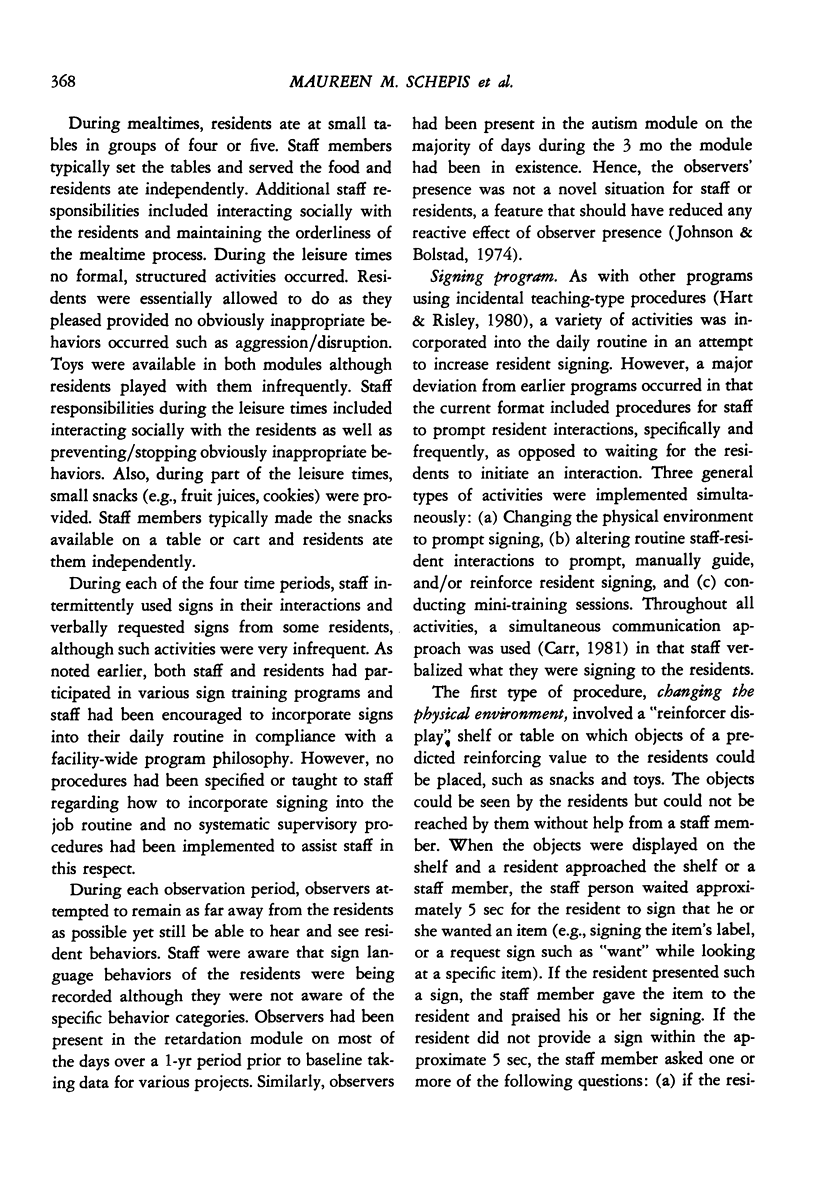
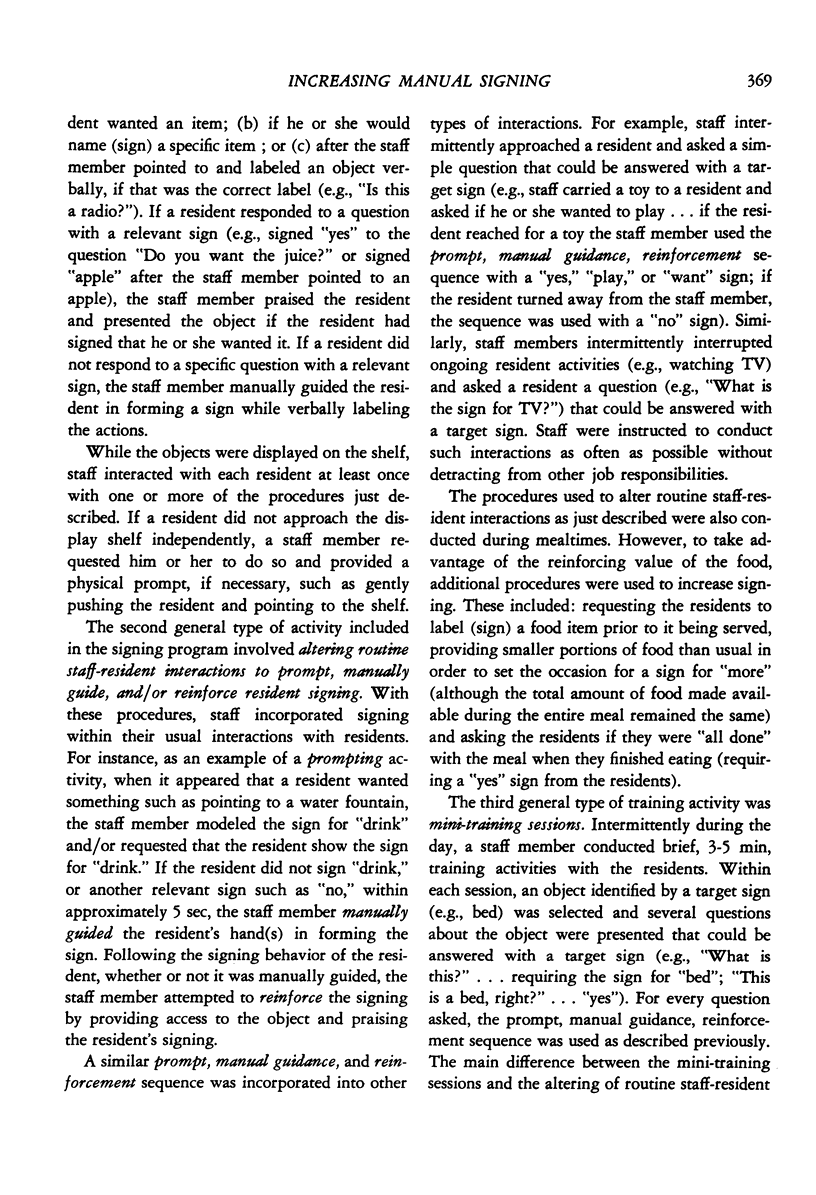

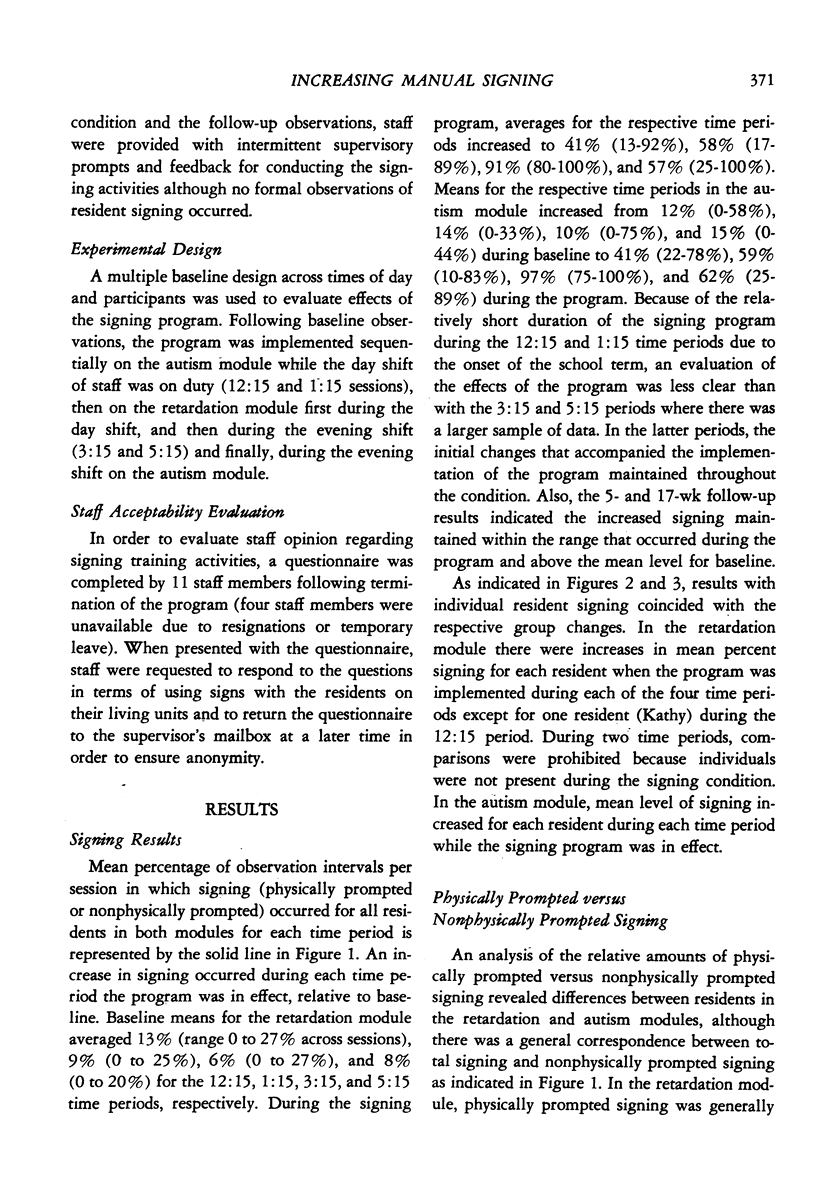
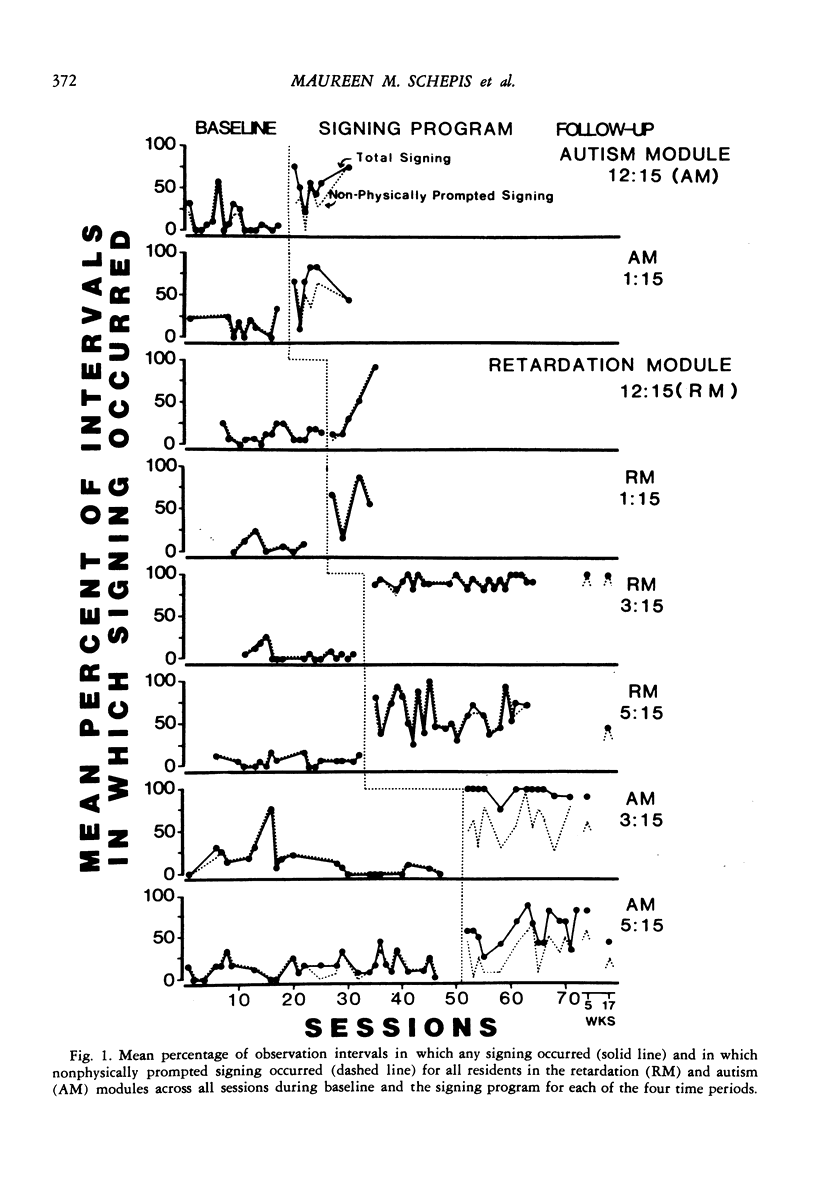

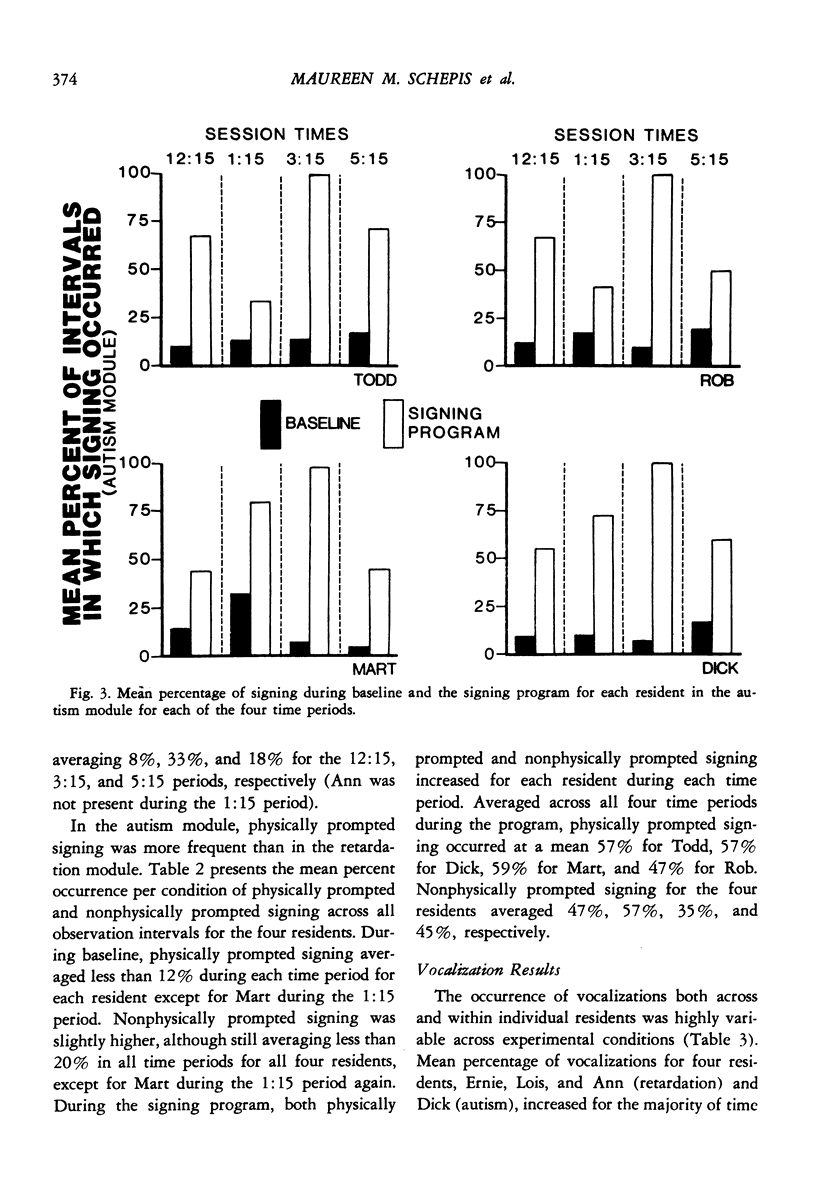
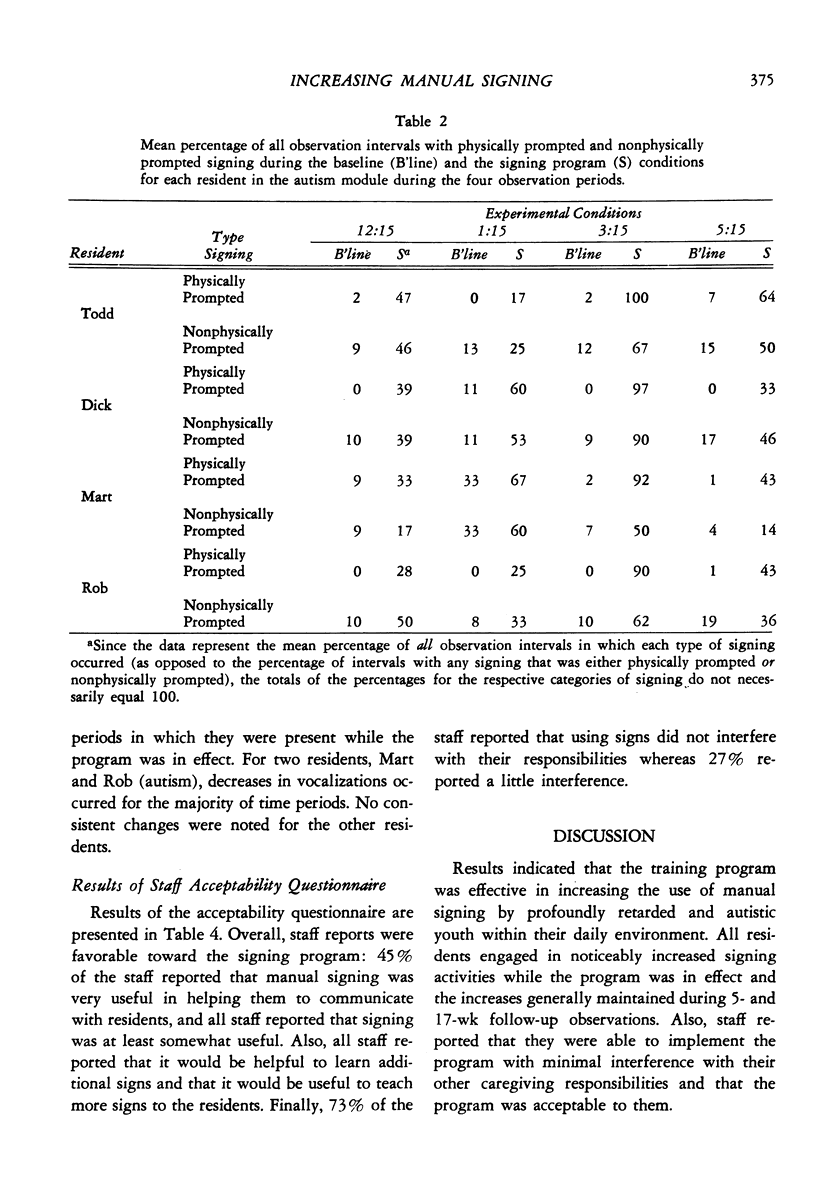

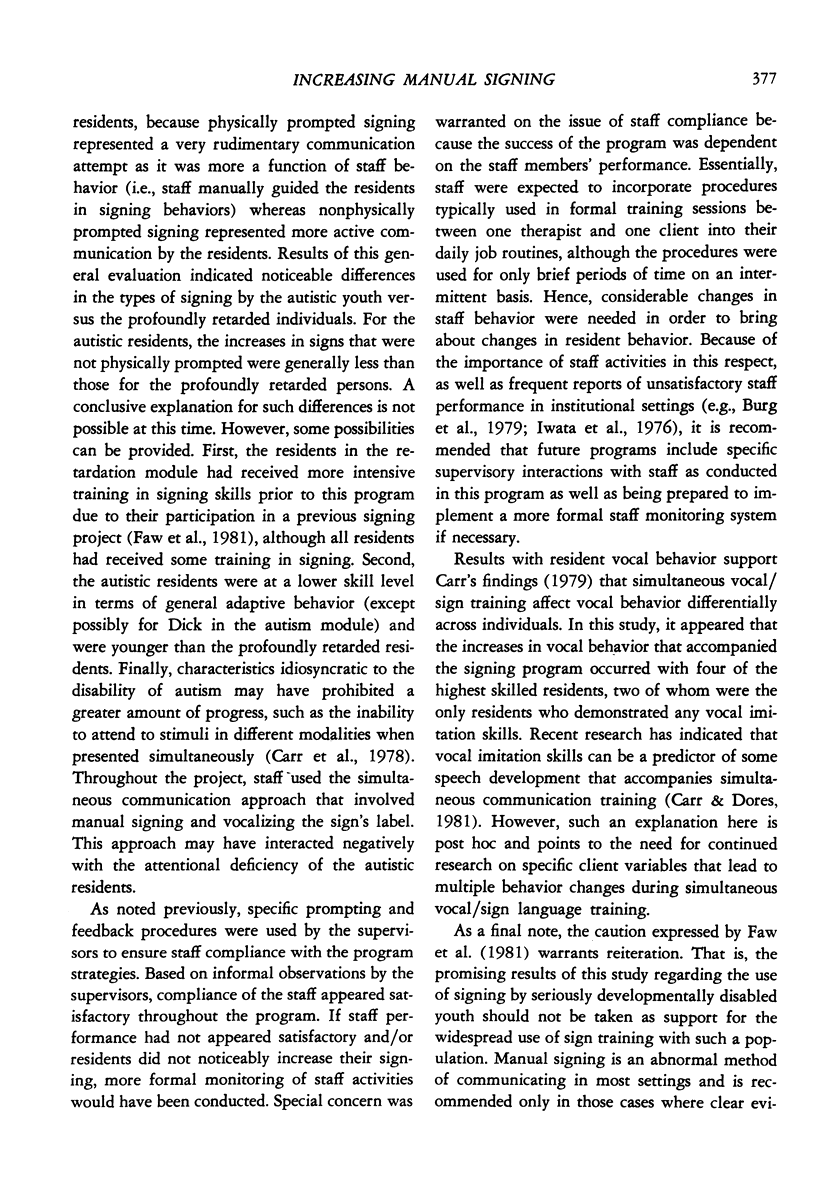


Selected References
These references are in PubMed. This may not be the complete list of references from this article.
- Burg M. M., Reid D. H., Lattimore J. Use of a self-recording and supervision program to change institutional staff behavior. J Appl Behav Anal. 1979 Fall;12(3):363–375. doi: 10.1901/jaba.1979.12-363. [DOI] [PMC free article] [PubMed] [Google Scholar]
- Carr E. G., Binkoff J. A., Kologinsky E., Eddy M. Acquisition of sign language by autistic children. I: Expressive labelling. J Appl Behav Anal. 1978 Winter;11(4):489–501. doi: 10.1901/jaba.1978.11-489. [DOI] [PMC free article] [PubMed] [Google Scholar]
- Carr E. G. Teaching autistic children to use sign language: some research issues. J Autism Dev Disord. 1979 Dec;9(4):345–359. doi: 10.1007/BF01531444. [DOI] [PubMed] [Google Scholar]
- Faw G. D., Reid D. H., Schepis M. M., Fitzgerald J. R., Welty P. A. Involving institutional staff in the development and maintenance of sign language skills with profoundly retarded persons. J Appl Behav Anal. 1981 Winter;14(4):411–423. doi: 10.1901/jaba.1981.14-411. [DOI] [PMC free article] [PubMed] [Google Scholar]
- Hall S. M., Talkington L. W. Evaluation of a manual approach to programming for deaf retarded. Am J Ment Defic. 1970 Nov;75(3):378–380. [PubMed] [Google Scholar]
- Halle J. W., Marshall A. M., Spradlin J. E. Time delay: a technique to increase language use and facilitate generalization in retarded children. J Appl Behav Anal. 1979 Fall;12(3):431–439. doi: 10.1901/jaba.1979.12-431. [DOI] [PMC free article] [PubMed] [Google Scholar]
- Hart B. M., Risley T. R. Establishing use of descriptive adjectives in the spontaneous speech of disadvantaged preschool children. J Appl Behav Anal. 1968 Summer;1(2):109–120. doi: 10.1901/jaba.1968.1-109. [DOI] [PMC free article] [PubMed] [Google Scholar]
- Hart B., Risley T. R. Incidental teaching of language in the preschool. J Appl Behav Anal. 1975 Winter;8(4):411–420. doi: 10.1901/jaba.1975.8-411. [DOI] [PMC free article] [PubMed] [Google Scholar]
- Hart B., Risley T. R. Using preschool materials to modify the language of disadvantaged children. J Appl Behav Anal. 1974 Summer;7(2):243–256. doi: 10.1901/jaba.1974.7-243. [DOI] [PMC free article] [PubMed] [Google Scholar]
- Ivancic M. T., Reid D. H., Iwata B. A., Faw G. D., Page T. J. Evaluating a supervision program for developing and maintaining therapeutic staff-resident interactions during institutional care routines. J Appl Behav Anal. 1981 Spring;14(1):95–107. doi: 10.1901/jaba.1981.14-95. [DOI] [PMC free article] [PubMed] [Google Scholar]
- Iwata B. A., Bailey J. S., Brown K. M., Foshee T. J., Alpern M. A performance-based lottery to improve residential care and training by institutional staff. J Appl Behav Anal. 1976 WINTER;9(4):417–431. doi: 10.1901/jaba.1976.9-417. [DOI] [PMC free article] [PubMed] [Google Scholar]
- Kahn J. V. A comparison of manual and oral language training with mute retarded children. Ment Retard. 1977 Jun;15(3):21–23. [PubMed] [Google Scholar]
- Kazdin A. E. Acceptability of alternative treatments for deviant child behavior. J Appl Behav Anal. 1980 Summer;13(2):259–273. doi: 10.1901/jaba.1980.13-259. [DOI] [PMC free article] [PubMed] [Google Scholar]
- Kopchick G. A., Jr, Romback D. W., Smilovitz R. A total communication environment in an institution. Ment Retard. 1975 Jun;13(3):22–23. [PubMed] [Google Scholar]
- Korabek C. A., Reid D. H., Ivancic M. T. Improving needed food intake of profoundly handicapped children through effective supervision of institutional staff. Appl Res Ment Retard. 1981;2(1):69–88. doi: 10.1016/0270-3092(81)90007-2. [DOI] [PubMed] [Google Scholar]
- Lovaas O. I., Koegel R., Simmons J. Q., Long J. S. Some generalization and follow-up measures on autistic children in behavior therapy. J Appl Behav Anal. 1973 Spring;6(1):131–165. doi: 10.1901/jaba.1973.6-131. [DOI] [PMC free article] [PubMed] [Google Scholar]
- Poulton K. T., Algozzine B. Manual communication and mental retardation: a review of research and implications. Am J Ment Defic. 1980 Sep;85(2):145–152. [PubMed] [Google Scholar]
- Reich R. Gestural facilitation of expressive language in moderately/severely retarded preschoolers. Ment Retard. 1978 Apr;16(2):113–117. [PubMed] [Google Scholar]
- Richardson T. Sign language for the SMR and PMR. Ment Retard. 1975 Jun;13(3):17–17. [PubMed] [Google Scholar]
- Sosne J. B., Handleman J. S., Harris S. L. Teaching spontaneous-functional speech to autistic-type children. Ment Retard. 1979 Oct;17(5):241–245. [PubMed] [Google Scholar]
- Topper S. T. Gesture language for a non-verbal severely retarded male. Ment Retard. 1975 Feb;13(1):30–31. [PubMed] [Google Scholar]


